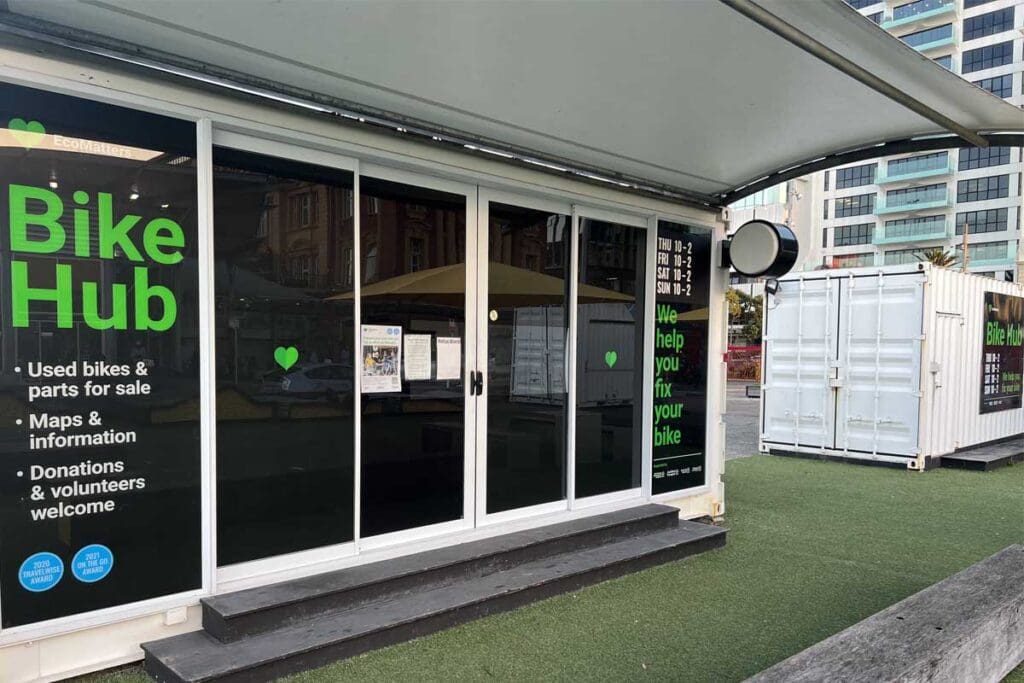Impressions of Auckland – What Can Australian Cities Learn?
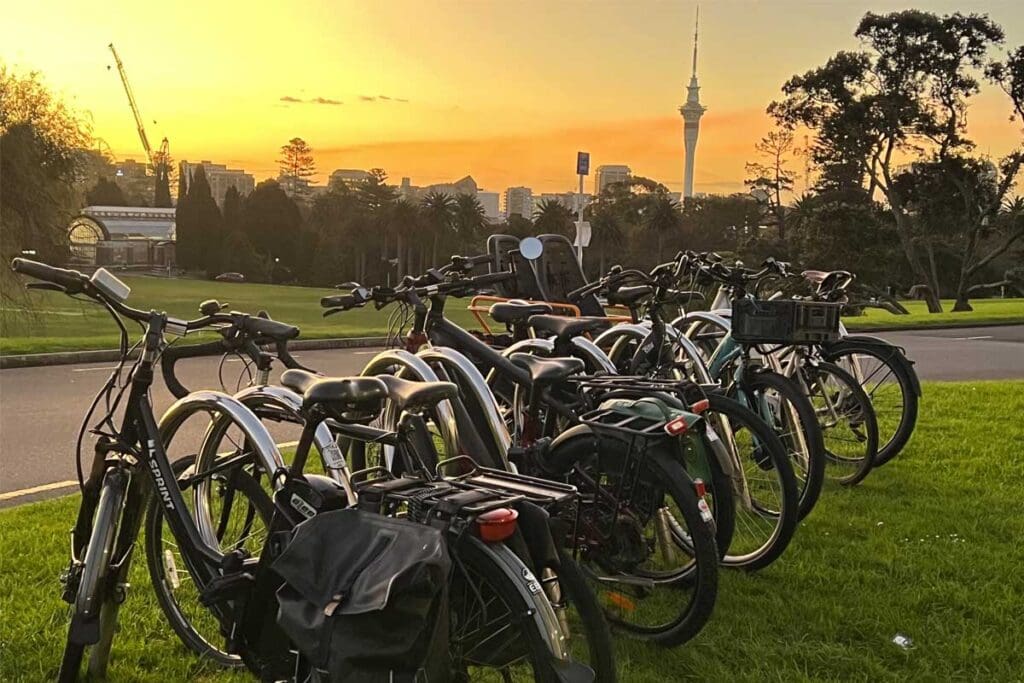
Auckland, New Zealand
Here at the Micromobility Report, we like to report extensively about what is happening in New Zealand. This is not only because our target audience is both Australia and NZ but because in many ways, NZ has been more progressive than Australia when it comes to various forms of micromobility regulation and infrastructure.
From 26th-28th April I made a brief visit to Auckland, NZ and had the opportunity to pack in a fair bit of riding on the city’s new micromobility infrastructure.
Perhaps my expectations were too high. Perhaps we’ve been guilty of only reporting upon positive news to come out of NZ. But whatever the combination of reasons, I’m sorry to say that overall I came away slightly disappointed by what I saw and experienced.
There were some very positive aspects, so let’s start with the good.
What’s Good?
Arriving in Auckland, I caught the regular public transport bus and train into my accommodation near the city centre. Unfortunately, there’s no direct rail link to the airport but the connection worked well.
Bikes are allowed on Auckland’s fleet of modern electric suburban trains but there are no bike racks on the buses.
Walking into the city the next day, it was nice to see the city centre is zoned 30kph, leading the way ahead of Australian cities. But from two days mainly spent in and around the CBD, it didn’t appear compliance with the speed limit was great.
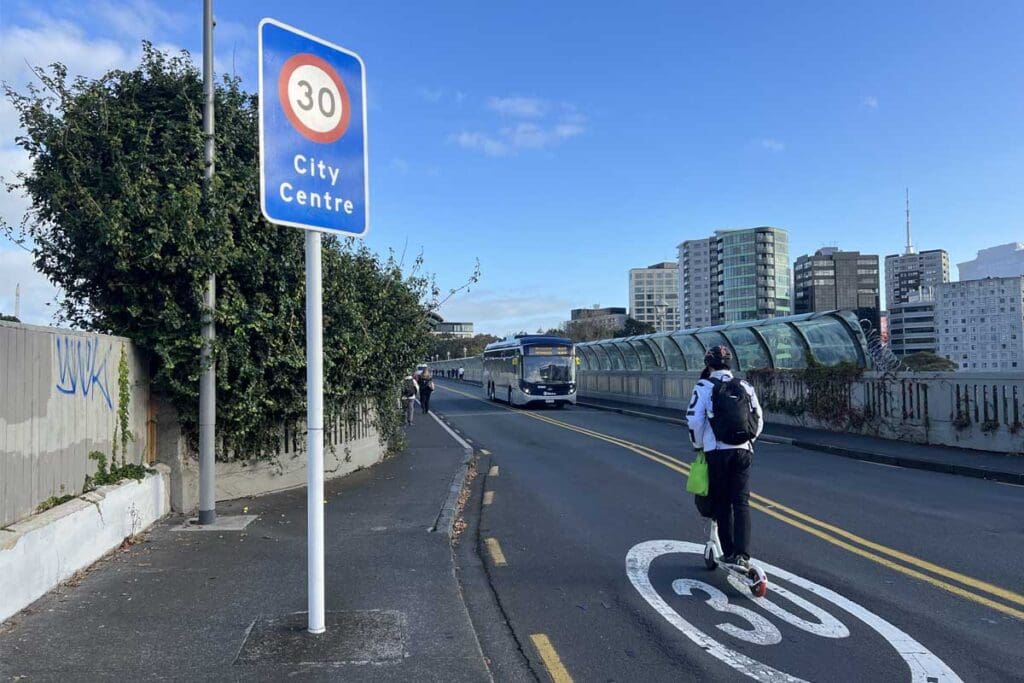
There are some wide, protected and separated shared paths and cycle lanes in Auckland.
I rode on the most prominent path along the waterfront several times and it was being well used every time I saw it.
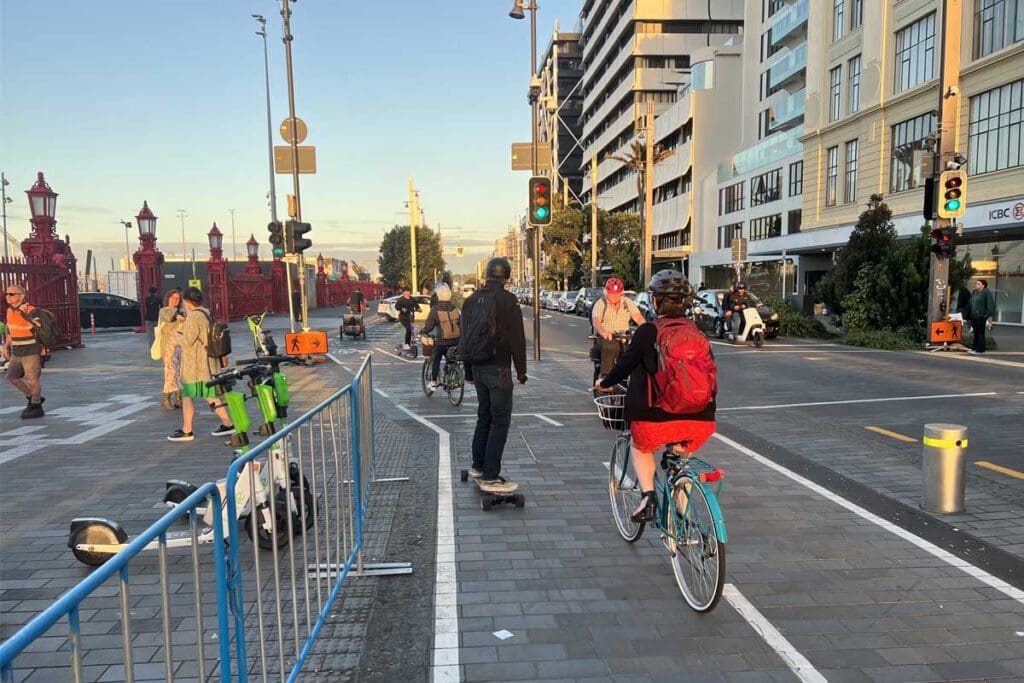
Aucklanders have embraced e-bikes, probably to a greater extent than in any Australian city. There are several compelling reasons for this. Firstly, it’s a very hilly city, including the CBD itself and many of the surrounding suburbs. Although I also saw a lot of non-electric bikes being ridden, they’re definitely for those who are looking for some serious exercise.
Secondly, regulations surrounding e-bikes and e-scooters are much more relaxed in NZ than in Australia. I’m not going to research and outline the exact details in this article, but there are no speed restrictions of e-bikes, only a power restriction of 300 watts. In practical terms this means some bikes can go up to around 45kph. This is even less regulated than Europe, where e-bikes of this speed capability are classified as ‘speed pedelecs’ or ‘S-Pedelecs’ and have an extra layer of requirements over the European standard 25kph pedelecs.
Privately owned e-scooters are also legal and a common sight in Auckland, though it’s interesting to see how they tend to stick closer to the CBD, with mainly just bikes being ridden once you’re a few kilometres out.
The e-bike I was riding during my stay had power assist up to 32kph. It might only be 7kph more than the legal limit in Australia but it made a noticeable positive difference, both on faster, quieter stretches of path and when mixing it with the motor traffic on Auckland’s busy roads.
Auckland Council is by far the largest local government area in either Australia or NZ. With a population of over 1.7 million, just over one third of all New Zealanders live within its boundaries. It covers not just the entire city, but almost 5,000 square kilometres, including extensive rural areas to the north and south of the city.
There are no state governments in NZ’s two-tiered government system, compared to three in Australia. It means Auckland Council has ownership and control of many functions that would be undertaken by a State government in Australia, including public transport, main roads (apart from the motorways) and other major assets.
This gives the council the scale and budget to potentially fund high-quality infrastructure problems and not have to worry about disconnects and the ludicrous situation of infrastructure arbitrarily stopping at a council boundary line, as often happens in Australian cities.
It has also helped Auckland council fund a major underground railway project called the City Rail Link. When opened in 2026 (if there are no further delays to construction), this will add underground train stations in the heart of the CBD and greatly increase the city’s public transport capacity.
Auckland’s flagship examples of good infrastructure also include the newly opened Glen Innes to Tamaki Drive shared path, which ticks the triple crown of good design and construction, a beautiful quiet scenic route and connecting people with important, relevant places such as schools and the city centre. Not surprisingly, it’s very popular.
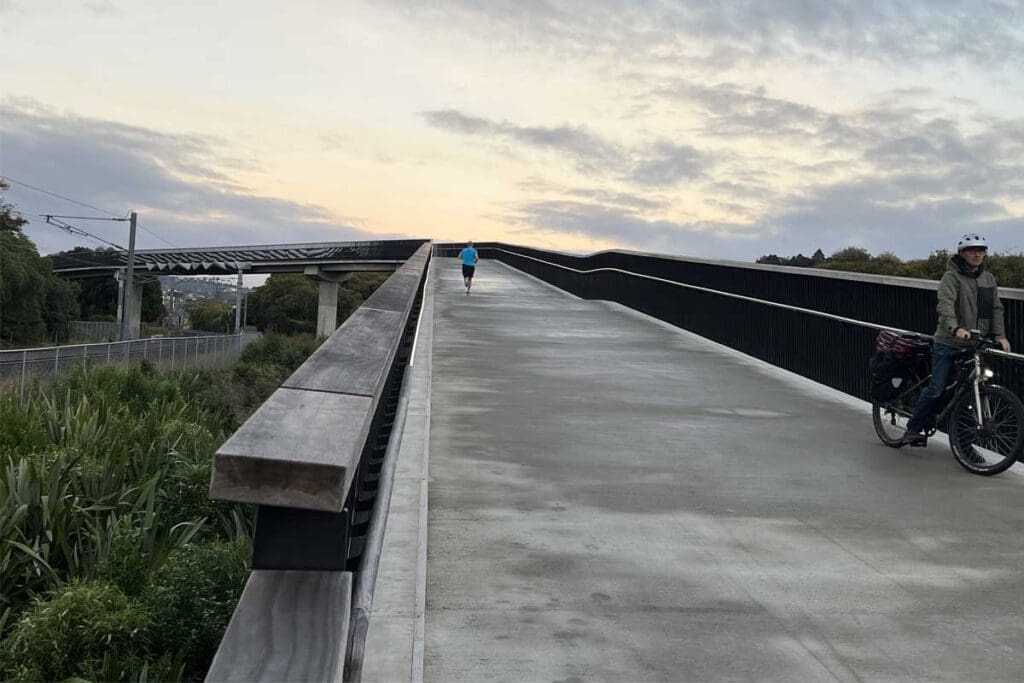
Bike and scooter share are popular in Auckland, with Beam and Lime appearing to be about equal in prevalence on the streets.
What’s Bad
Auckland is every bit as car-centric as any Australian city. There are many missing links in micromobility infrastructure.
Parts of the city centre remind me of Melbourne 30 years ago. Excessively wide streets including ‘traffic sewers’ connecting to the urban motorway, very few street trees and long wait times for pedestrians and cyclists at signalised intersections.
The mode shares for all non-motoring transport, including trains, busses, cycling and walking, is still very low in Auckland. Although the non-motoring modes have grown slightly over recent decades, by far most common mode of transport is still a single occupant in a car.
At the afternoon peak hour, I observed a long queue of people waiting for buses at one of the main city bus stops on Lower Albert Street. The queue wrapped around a corner onto Customs Street West at the point where it merges with Fanshawe Street. People in the queue and pedestrians trying to walk in both directions were all crammed onto a narrow footpath, next to an excessively wide, six-lane, cycling-hostile road. If Auckland is serious about active transport, reallocating some road space here would be a good place to start.
Auckland’s ‘best’ city street is its main shopping precinct along Queen Street. But even here, the car is king. While every major Australian city has at least turned a couple of blocks of their main shopping street into a car-free mall, the main shopping section of Queen Street is still open to cars … albeit with some wider footpaths, a cycle lane and some good street landscaping in certain sections.
At least the final block of Queen Street before the harbour has recently been closed and landscaped. This is also the entrance to the city’s existing main rail terminal, Britomart.
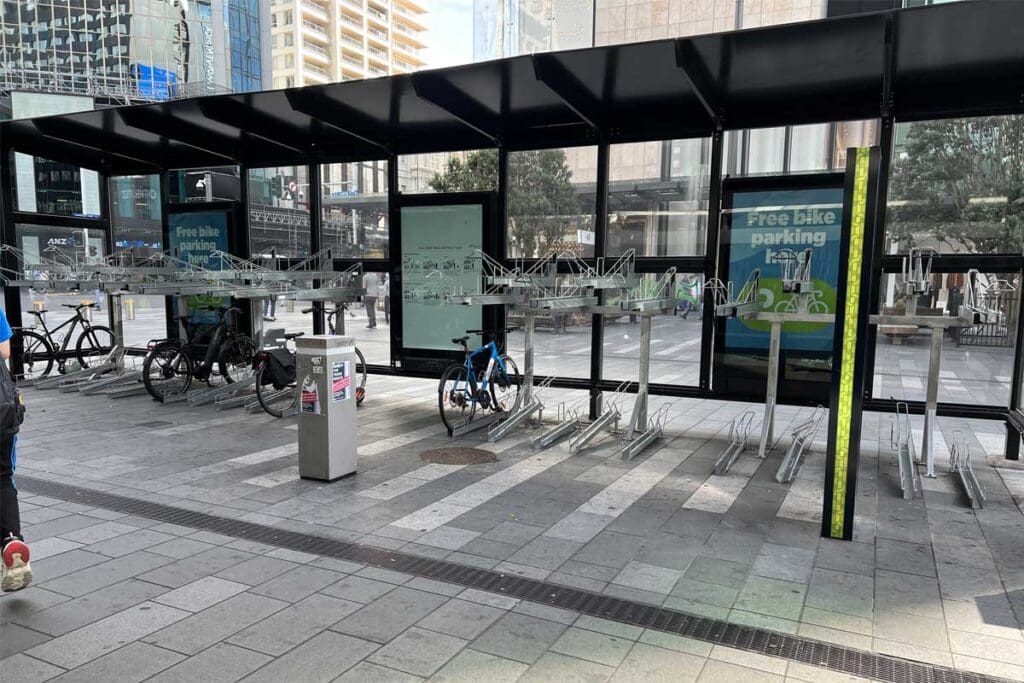
During my first 15 minutes walking along Auckland’s streets, I counted more than a dozen electric cars, mainly Teslas. A quick search revealed NZ is subsidising electric car purchases by up to NZ$8,000 each (A$7,4,76). Many people might say this is a good thing. It has certainly been effective. NZ’s EV market share of new vehicle sales was 15% in 2022 and accelerating to 20% in recent months. That’s more than five times higher than Australia’s 3.6%.

But imagine how transformational such a vast taxpayer subsidy would be if devoted to micromobility?
Another negative (that’s certainly not credible to draw a concrete conclusion from a two-day visit) is community attitudes. In two days of cycling and walking, I had four incidents: including being aggressively shouted at to ‘get on the bike lane’, twice beeped at to get off the road more quickly and cut off by a cab driver who had no interest in giving way to what I thought was a priority bike lane that I was riding along. I also spoke to several locals, including women who commented they wouldn’t ride in Auckland because of the traffic and perceived danger.
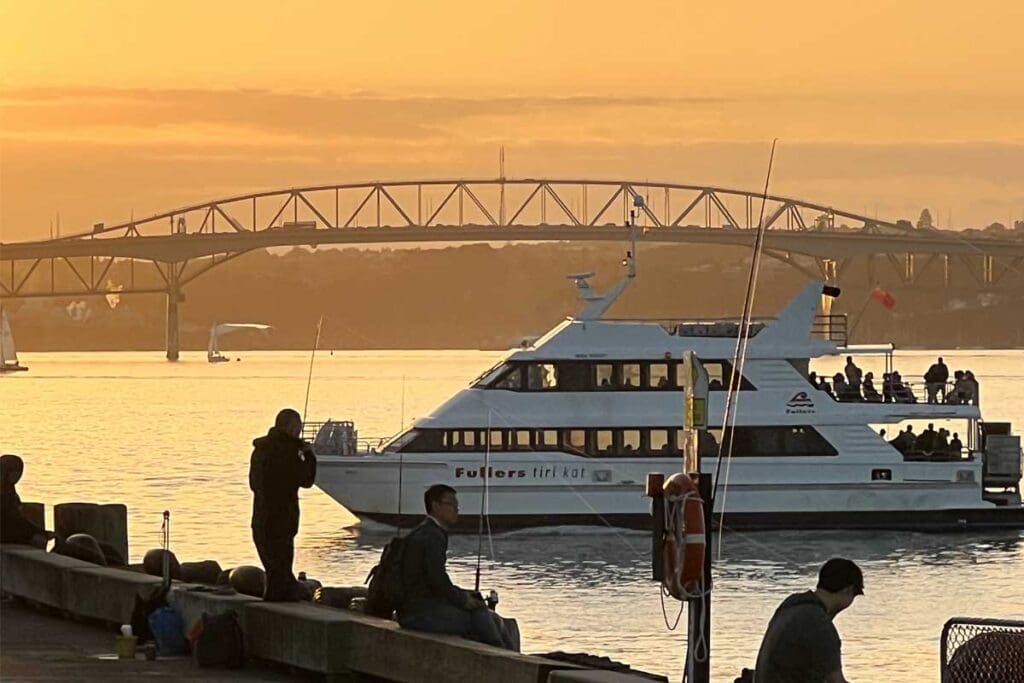
The city’s elephant in the room when it comes to micromobility is the Auckland Harbour Bridge. Whilst not quite as grand as the Sydney Harbour Bridge, Auckland’s Harbour Bridge is possibly an even more critical piece of infrastructure because, unlike Sydney, there are no tunnels or other nearby bridges crossing the harbour.
Despite multiple proposals and protests, there is still no non-motor vehicle access across the bridge. All eight lanes are for cars, trucks and other motorised vehicles. Adding an extra bridge or building an extra lane for micromobility would be expensive, and it appears the Auckland public and its elected officials are not even ready to consider the far cheaper option of simply reallocating one of the existing lanes.
This would require a change of mindset and political courage, but if multiple cities around the world can successfully do this, from London to Vancouver and even twice in New York City on two of its most famous and busiest bridges, there’s no reason this strategy would not work just fine in Auckland.
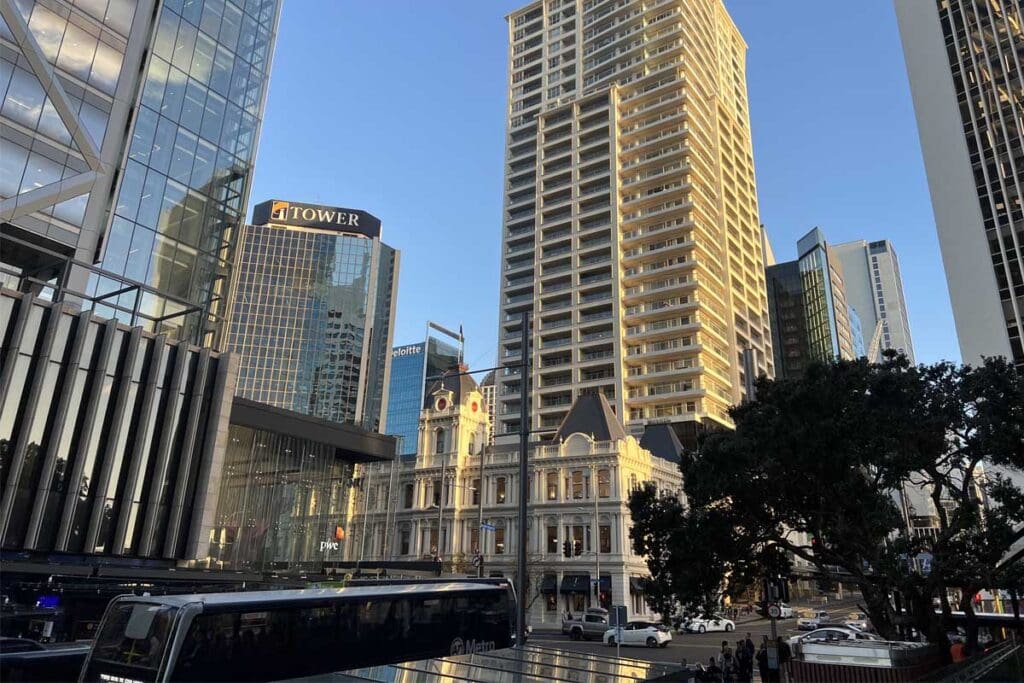
Future Challenges
Last year, Auckland City elected a conservative mayor whose campaigning was apparently centred around reducing funding for bike infrastructure.
Completion of previously approved and commenced projects is cushioning the short-term impact in Auckland, but the medium-term future is looking less promising for advocates of micromobility.
In addition, NZ is heading to a federal election on 14th October 2023. Current polling is very tight, with the opposition National Party apparently pushing back against all things ‘woke’, of which micromobility is always a visible punching bag. Meanwhile, the incumbent government seems to be very cautious regarding any progressive policy announcements, in an effort to hold onto the centre ground and remain in power.

The situation varies between NZ’s three largest cities, with Christchurch also electing a conservative mayor in its local elections last year, while Wellington has moved to a more progressive council overall.
Regardless of what happens on the political front, there are dedicated and experienced professionals working within both levels government and community groups who want to see continued progress. Although they don’t have the power of elected politicians, the neck can still turn the head and the micromobility genie will not be going back into the bottle any time soon, either in Auckland or NZ more broadly.
